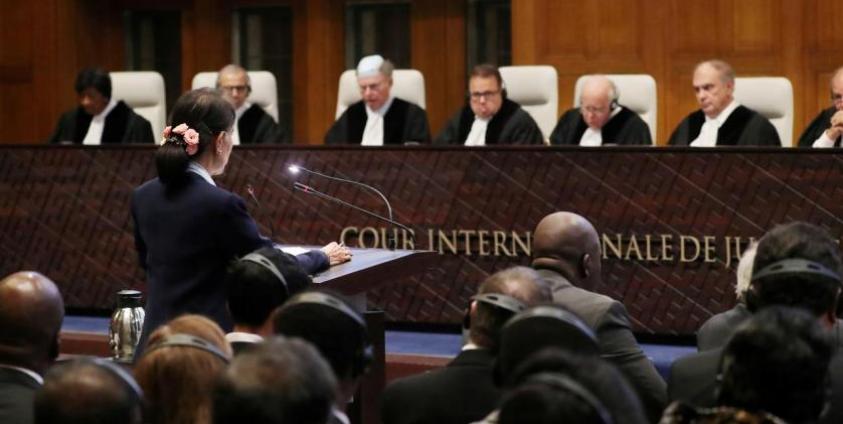On May 23, the Burmese government delivered its first report to the International Court of Justice (ICJ), detailing what it has done to protect the minority Rohingya from genocide.
The Hague-based court issued a provisional order in January, asking Myanmar to safeguard the mostly Muslim group in western Arakan or Rakhine State as part of “provisional measures”, which includes four points.
First, it has protect the Rohingya from genocide; second, Myanmar army or Tatmadaw and its security forces not to commit genocide; third, to preserve and protect evidences; and fourth, to report within four months starting from the day the ICJ issued order, including tabling reports every six months until a final verdict is made on the issue.
Reportedly, The Gambia’s attorney general, Abubacarr Marie Tambadou said they are reviewing three main points of whether defending and prevention of genocide; avoiding genocide; and safeguarding and preservation of evidences are observed by the Myanmar government.
To date, Myanmar’s report has not been made public by the ICJ but international observation and reports indicated that the country is not obliging to the four-point ICJ provisional order, although the Myanmar President Win Myint has ordered that the regional government and military not to remove or destroy evidence of genocide, gave instructions to prevent genocidal acts and as well as incitement and hate speech against the Rohingya.
“A continuing genocide Burmese Rohingya Organisation UK – Briefing” of May 2020 quoting from various reputable international and domestic media writes:
Just two days after the ICJ ordered provisional measures, two Rohingya women – one of whom was pregnant – were killed and seven others injured when the Tatmadaw shelled the Rohingya village of Kin Taung in Buthidaung Township.
On 10 February a 15 year-old Rohingya boy in Taungbwe village, Kyauktaw Township was killed by shelling reportedly fired from a Myanmar naval vessel on the Kaladan river. Four villagers were injured, including two other teenagers.
On 29 February five Rohingya – including a 12 year-old boy – were reported to have been killed by Tatmadaw shelling in Bu Ta Lone village in Mrauk Oo Township, with several others injured.
On the same day, several Rohingya and Rakhine villagers from Myaungbwe village in Mrauk Oo Township were injured in fighting between the Tatmadaw and the Arakan Army, while others were reported to be missing. Rohingya have also been killed and injured by landmines.
On 15 March a 25 year-old man was killed by a landmine in the area known as No Man’s Land, which was reported to have been mined by the Tatmadaw during their clearance operations.
On 13 May two Rohingya children were killed and another injured by landmines in the Thayatpyin village tract area of Buthidaung township, although it is unclear whether the Tatmadaw or the Arakan Army were responsible for planting landmines in the area.
The Guardian recent report of May 25 writes: “Less than three years since a crackdown against Rohingya, troops are again accused of war crimes – this time against Rakhine Buddhists.”
The report reconfirmed the mass detention, harassment of the Arakan population and all sorts of human rights violation already well known in the public.
Yanghee Lee, who recently stood down as the UN’s special rapporteur on human rights in Myanmar, said the military is increasingly targeting civilians, using tactics reminiscent of the 2017 assault against Rohingya that caused global outrage: homes have been burned, civilians detained and disappeared, according to the report.
“I think the international community should be really scared of what might happen,” said Lee, who urged the UN and its member states to act.
To drive home its point, The Guardian inserted two aerial satellite images of the torched population settlement by the Military or Tatmadaw.
Satellite imagery provided by Planet Labs Inc and analysed by Human Rights Watch confirms about 140 buildings were affected by fire in Tin Ma, likely occurred between March 22 and 23, 2020; and about 180 buildings affected by fire in another village, Pyaing Taing, also in Kyauktaw township, were said to have likely taken place also in March.
“The Guardian is aware of 19 other reports where civilian homes in Rakhine and Chin states were apparently damaged by fighter jets or artillery or burned since January,” according to the report.
While it seems the president is making efforts to look good in its ICJ report recently been delivered, which has not been publicized so far, the situation on the ground doesn’t look like that the Myanmar government is adhering to the provisional measures of the ICJ, if what is unfolding recently in the media are to be taken as indications.
And thus, question arises if the government has any intention to right the wrong with proper repentance in its agenda in addressing the genocide intent accusation of the ICJ. It looks like regarding the Rohingya nothing has improved and they continue to suffer against human rights violations, including death.
And with regards to another ongoing new conflict, between the Tatmadaw and Arakan Army resulting in massive human misery, which created hundred thousand internally displaced persons and hundreds of civilian death, military solution is the preferred policy option for the government. So far, appeals to end the civil war and persuasion to conduct an all-inclusive political dialogue, without pre-condition, have only fallen on deaf ears.
Photo - aung san suu kyi appears in court in case filed by gambia against myanmar alleging genocide against the rohingya population at the icj in the hague netherlands december 11 2019 reuters







